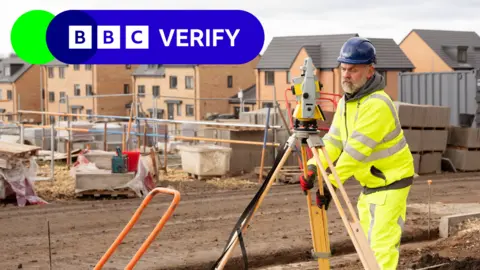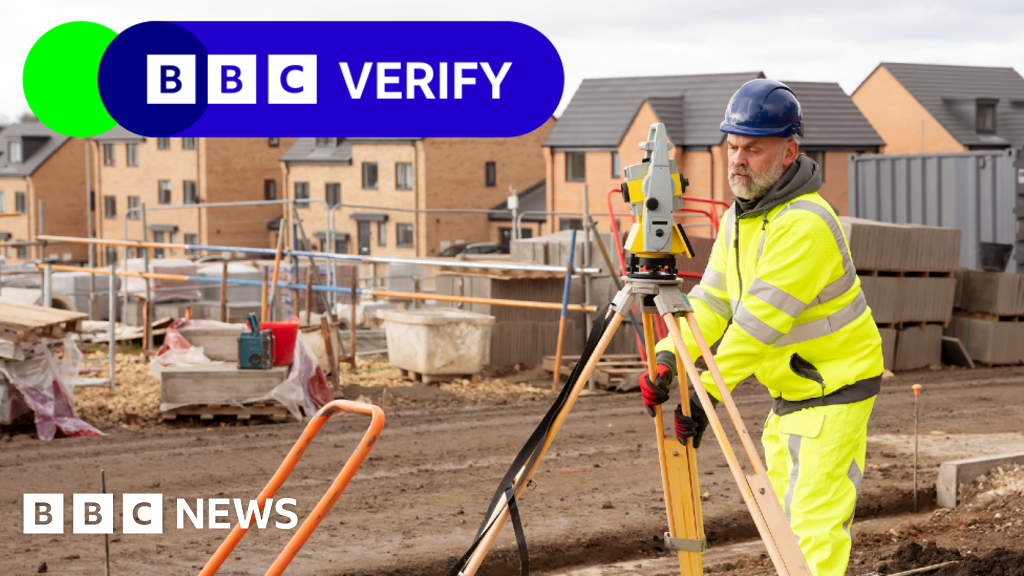 Getty Images
Getty ImagesLabour has announced plans to build on the “grey belt”, as it tries to meet its pledge for 1.5 million new homes over the next five years.
Chancellor Rachel Reeves said an overhaul of planning rules would see councils in England expected to prioritise building on brownfield sites and poor quality areas in the green belt.
What is the ‘grey belt’?
Labour has previously described the grey belt as “poor quality and ugly areas” – including disused car parks and wasteland – on parts of protected land, called the green belt.
The green belt, which was established more than 70 years ago, covers about 13% of England. Its aim was to limit the growth of large built-up areas and to stop large towns merging into one another.
Labour wants grey belt land to be used for new homes, with half to be affordable housing.
It has pointed to a disused garage in Tottenham, north London, as an example of a green belt site that cannot be developed into housing because of its designation.
 Siobhain Mcdonagh MP
Siobhain Mcdonagh MPHowever, Sam Stafford from the Home Builders Federation says it is crucial that the new grey belt is clearly defined.
“If you don’t properly define what the grey belt is, what’s to stop existing green belt land becoming ‘scrubby’ and ‘ugly’ just so it can be sold for development? If it’s going to be a new class land of it needs to be defined in an objective and robust way.”
For example, former golf courses and land used for mineral extraction could be designated as grey belt, Mr Stafford suggests.
How big is the grey belt and how many homes could be built on it?
As the grey belt will be a new category, there is no official data on how much of it exists.
However, estate agent Knight Frank has previously carried out its own analysis.
It has identified 11,000 previously developed sites, making up less than 1% of the existing green belt.
The sites are mainly concentrated in the south of England with just over 40% within the London green belt area.
In total, 100,000-200,000 new family homes could be built on the sites according to Knight Frank.
 Getty Images
Getty ImagesNevertheless, Mr Stafford believes that building on both the grey belt and additional brownfield sites in urban areas will be necessary to meet England’s housing needs.
“There just isn’t the land within major towns and cities to meet the housing need in its entirety,” he said.
To support his claim, Mr Stafford points to a 2022 report by planning consultancy Lichfields which found that even if every identified brownfield site in England was built to its full capacity, that would mean 1.4 million extra homes.
That is less than the housing target of both major parties ahead of the election. Labour pledged 1.5 million new homes in England and the Conservatives 1.6 million.
Will grey belt homes be affordable?
Labour says the grey belt developments must offer 50% affordable housing. This includes homes that are let at least 20% below local market rents.
However, Charlie Hart from Knight Frank says this could be hard to achieve as inflation has significantly pushed up costs for developers.
Katie Townsend from the Centre for London think tank says that although the plan is for grey belt homes to be built by private developers, the government should consider stepping in.
“The best way to ensure affordable houses are built, particularly socially rented homes, is to increase government investment”, she says.
Does the public support building on the grey belt?
Labour floated the idea of creating the grey belt long before the election.
When Sir Keir Starmer mentioned it over a year ago, then prime minister Rishi Sunak ruled it out as he “wanted to make sure our green spaces are protected”.
Building on the green belt is controversial.
However, Ms Townsend of the Centre for London says attitudes might be shifting, pointing to polling showing half of Londoners supported building strategically on low-quality areas of the green belt, with only 19% against it.
Others disagree. Countryside charity CPRE Oxfordshire, for example, says land is “already under enormous pressure”.
Its director Helen Marshall says: “Ten years ago we commissioned research which showed that over 70% of Oxfordshire wanted the green belt to remain undeveloped.
“Ten years later support for the green belt has increased to over 80%.”
However, Mr Hart of Knight Frank says that while the green belt used to be seen as a “don’t go zone”, perceptions are shifting.
“It was conceived a long long time ago and the world is a very different place and we’re now reviewing whether it’s fit for purpose in the modern world.”
Additional reporting by Gerry Georgieva



